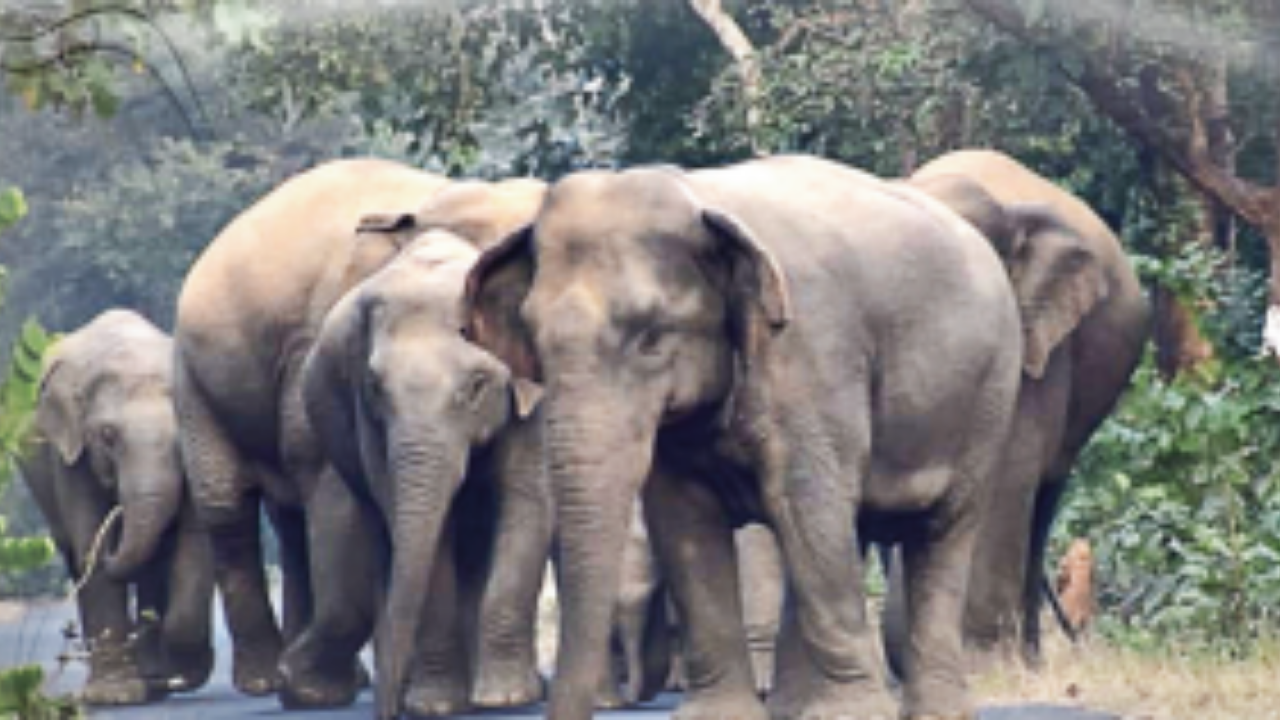
RAIPUR: On a very challenging wild elephant trail in Central India, TOI’s Vijay Pinjarkar gives a first-hand account of how the pachyderms are wandering in search of secure spaces for survival.
Elephants have been part of our culture since time immemorial but, now, these goliaths are facing the worst-ever crisis for their continued existence. On a five-day trail of the largest living land mammals through the Red Corridor from Maharashtra’s Gadchiroli district to Dhamtari, Udanti-Sitanadi Tiger Reserve (USTR), Mahasamund, and Barnawapara Wildlife sanctuary in Chhattisgarh was an ultimate experience on how elephant habitats are shrinking with the animals being challenged in their own den.
The history of elephant occupancy in the eastern Central Indian landscape had an increasing trend. But now there is a forceful eviction from their natural habitat, mainly from Odisha and Jharkhand due to large-scale mining activity. Herds of elephants are wandering in search of secured and suitable spaces for survival.
Elephants started migrating from Odisha and Jharkhand to Chhattisgarh in the 1980s, and from Chhattisgarh now they have started entering MP and Maharashtra. A herd of 40 elephants that traveled from Chhattisgarh in 2018 strayed into the Bandhavgarh Tiger Reserve and surrounding forest divisions and did not return.
The animals require anything up to 5,000 sqkm of forest and everyday they wander for 25km. In November 2019, two male elephants — Ram and Balram — had crossed over to Kochinara in Korchi in Gadchiroli from Chhattisgarh’s Manpur in Rajnandgaon district for a brief period. The jumbos were pushed towards Darekasa in Gondia and later they moved towards Pachmarhi. One of them was electrocuted.
On October 17, one such herd of 22-23 elephants entered Gadchiroli’s Murumgaon and Dhanora ranges and left after a 5-month stay on March 16. The elephant corridor from Chhattisgarh to Gadchiroli was the tip to go through these regions which are historically elephant corridors.
“There are two possible routes from where the elephants must have entered Gadchiroli. One is the Barnawapara-Mahasamund-Gariyaband-Dhamtari-Balod-Dalli Rajhara-Ambagarh-Malewada-Murumgaon-Dhanora, and the other is through Udanti-Sitanadi-Dhamtari-Manpur-Murumgaon-Yerkad-Dhanora,” assert Uday Patel, Gadchiroli honorary wildlife warden, and Prafulla Bhamburkar, advisor, Wildlife Trust of India (WTI), both of whom were part of the travel.
TOI travelled 1,100 km through this full circle from Gadchiroli to USTR and Barnawapara and back through Rajnandgaon to the Navegaon-Wadsa elephant corridor. We started from the banks of the mighty Wainganga River (the lifeline of Central India) where the elephants had entered recently.
The herd of 23 elephants wandered across Odisha, Chhattisgarh and into Maharashtra. It had almost reached the Wainganga River in December last but could not move towards Chandrapur due to fragmented connectivity.
The valley of Wainganga has served as a backdrop for Rudyard Kipling’s Jungle Book, and the East Vidarbha region of Maharashtra hosts a major part of this lush green landscape which is ecologically one of the most significant regions of India and was once a rich elephant habitat. More than 50% of the forest of the state falls in this region.
As we moved on NH960, crossing the sensitive Murumgaon and Chatgaon forest ranges in Dhanora, having Maoists’ imprint, there were display boards alerting locals about the presence of tigers in the area but not elephants, though they had already made their presence felt in Tippagarh closeby. The hilly area has rock formation like the Deccan trap, laterite etc, which contributes to the luxuriant growth of vegetation at the foothills.
At Kulbhatti on the elephant path, we stopped at Bajagad where locals Vilas Walde and Bidesh Raut told us that the herd of elephants that entered Gadchiroli passed close to their village.
After a 200km tiring journey through forested patches of Dabba Hills (natural stacking stones), Manpur, and Bhanupratappur, we reached North Bastar’s Kanker district. According to Ramayana and Mahabharata, this area was once a dense forest named Dandakaranya.
Kanker is surrounded by five other districts of Chhattisgarh – Kondagaon, Dhamtari, Balod, Narayanpur and Rajnandgaon, which experience considerable Naxalite insurgency and are also known for elephant movement. During the five-hour travel, there were several elephant tales from the locals.
We made a halt at Kanker as forester Sandeep Singh explained why it was risky to travel further to Udanti-Sitanadi during the night hours. He also informed how elephants reach Kanker from Dudhawa dam and Dhamtari. Travelers have sighted them many times in Charama, 32km from Kanker.
Singh informed that in 2018, a female elephant named Chanda was collared by the forest department officials. The female moved in Kanker and Dhamtari area with her herd. He also recalled Likhma village in Dhamtari, which was an elephant mating centre during the British era and one can still find the ‘Hathi Gadda’ of 20-metre radius there.
The next morning we left for the Sitanadi wildlife sanctuary from Kanker. Both Udanti-Sitanadi sanctuaries together form 851 sqkm of the core area and 1,842 sqkm of core plus buffer. The USTR derives its name from these two rivers Udanti and Sitanadi which are flowing between both sanctuaries.
As we moved ahead, we came across the Sitanadi, Sondur and Lelang rivers, which join the huge Mahanadi River flowing through Chhattisgarh and Odisha to finally merge in the Bay of Bengal. Elephants also use these rivers to cross over.
In Sitanadi, we met forest labourer Premlal Markam, working in the Arsikanar beat. “There was a herd of 30 elephants near Bira village in the tiger reserve for the past two months. In 2018, a small herd had entered Sitanadi but this year the same herd has returned with big numbers,” said Markam.
The distance between Udanti-Sitanadi is about 30km with a corridor of good forest cover. Both these sanctuaries form a compact forest for the free movement of wildlife. However, from Gadchiroli to Chhattisgarh, we found that the elephant habitat was fragmented with many villages occupying land in the midst of the forest.
“There are 51 villages in USTR (17 in Udanti and 34 in Sitanadi). The herd which reached Gadchiroli had moved ahead through the tiger reserve only and reached Maharashtra through Rajnandgaon. The reserve has bamboo and a large number of mowai (Lannea coromendelica) trees which act as good fodder for elephants,” says Dr Rajendra Prasad Mishra, WTI’s regional head, Madhya Pradesh and Chhattisgarh.
Mishra said that Chhattisgarh borders Jharkhand and Odisha and is in the path of elephants hence it frequently sees their movement. There are nearly 250 elephants in the state spread in a 30,000 sqkm area.
Even after long excursions for two days, elephants continued to be elusive. We found that their traditional corridors were blocked due to forest fragmentation and habitat destruction and shortage of food.
During a visit to Barnawapara, a wildlife sanctuary about 170km from USTR and 100km from Raipur on NH6, Mishra told us there is a herd of 12 elephants in the sanctuary. Named after Barnawapara village, we saw a long trail of elephant footprints on a paddy field outside the park, indicating how pachyderms were turning to fields for fodder causing frequent interface with humans. Inside the sanctuary, there was an early morning trail of footprints on the road in the Kothari range.
Mishra says, “Now that we have come to know about the elephants’ corridor between Chhattisgarh and Maharashtra, both the states should do a reality check and safeguard these corridors for the future because elephants follow the same migratory routes and select more hospitable locations near rivers and water sources that are not prone to drying.”
There were display boards in forest patches of Mahasamund district mentioning elephant corridors. While returning to Maharashtra, we took the forested patches surrounding Navegaon sanctuary and national park, which connect Chhattisgarh and also to Salekasa and Darekasa in Gondia district.
We also met Narayandada Dongarwar Patil (70), the descendant of the Dongarwar family instrumental in carving out Navegaon National Park and lake. Patil, who resides in Dhabe Paoni near Navegaon, said, “This belt has been known for elephants for over 350 years.”
Bhamburkar says, “The Highlands of Central India, a book written by a British author James Forsyth in 1874 on the forest, wild tribes, and natural history, makes no mention about the presence of wild elephants in the Eastern Vidarbha Landscape (EVL) after the 18th century. In the late 1800s, elephants were common in the northern reaches of Maikal Hills in the north of Bilaspur. Forsyth estimated 200-300 elephants in 3,000sqkm. This population was a western extension of Sirguja, Chhota Nagpur and Cuttack.”







